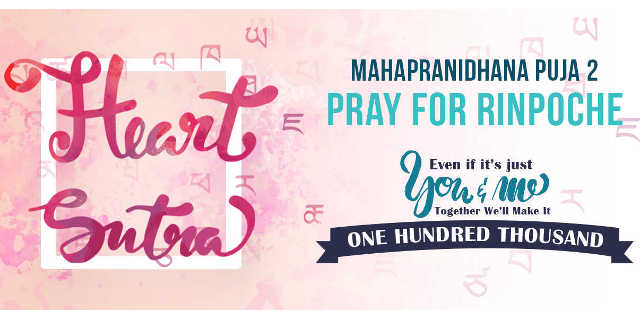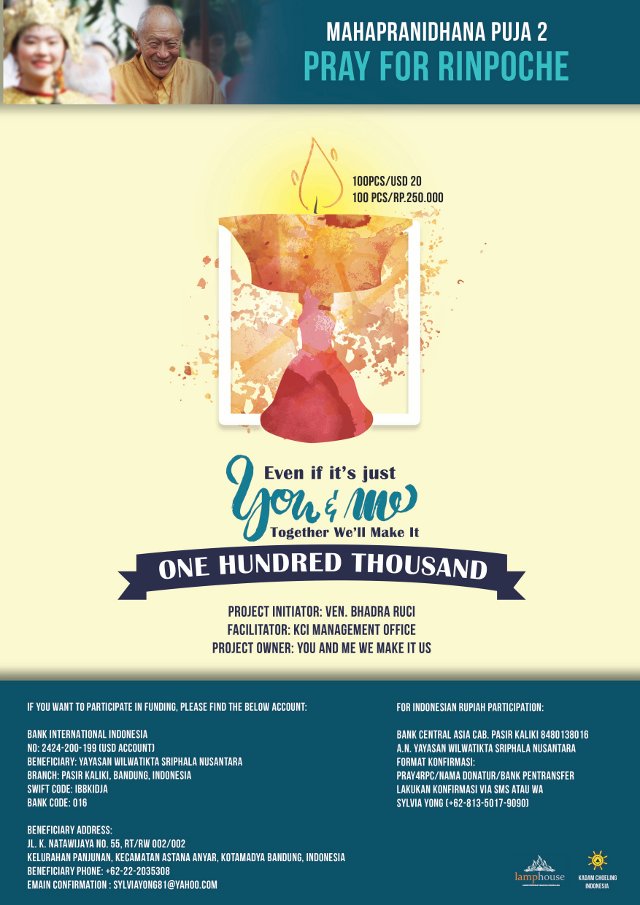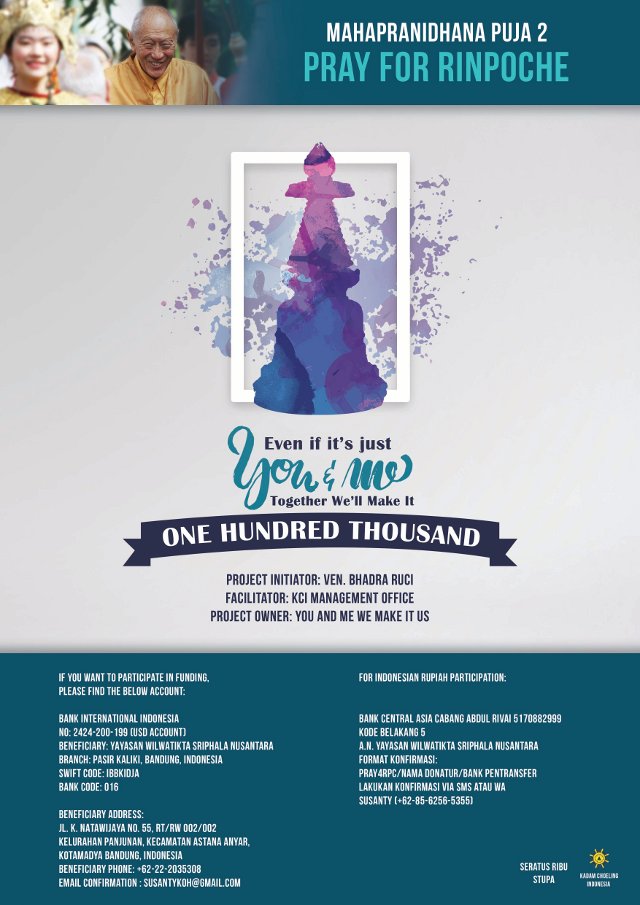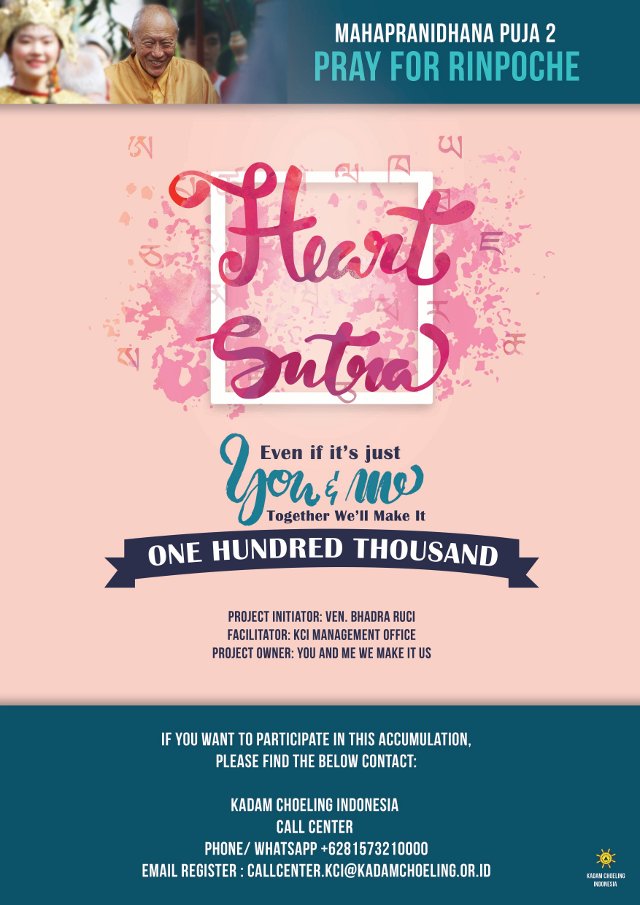
Pray for Rinpoche : Together We’ll Make It One Hundred Thousand
In November 1983 I was invited to teach by the Maitreya Institute in Holland, an invitation that would lead to new developments in my activities. There, I explained “mind training” as transmitted by Kusali, a great Indian master of the tenth century. The Dutch asked me to return.
I was traveling more and more often within western Europe and in different French cities at the invitation of Buddhist institutes and universities. In one I would teach calm abiding (shamatha), in another mind and its functions or karma, reincarnation, the four noble truths, and so on. I participated as well in the first meeting of the Gelugpa masters of Europe, organized by Geshe Rabten. During the fifteenth meeting, held in Milan in October 1997, I was elected vice-president in spite of my reluctance.
At the Maitreya Institute I had become friends with Indonesians of Chinese origin. We would have long conversations about the wonders of Boroboudour, the Buddhist masterpiece built around 800 at the top of a hill, which I had for a long time dreamed of visiting.
Lan Tjoa, a Sino-Indonesian woman, very dynamic and courageous, had learned from my friends that my predecessor was known to be the incarnation of Serlingpa or Suvarnadvipa Guru, a king of an Indonesian island in the tenth century, important Buddhist figure, and master of the great Atisha. In February 1989 Lan Tjoa expressed her belief that I should go to Indonesia to revive Buddhism. She had felt drawn to Buddhism after spending several years following the spiritual path of a Chinese teacher, Laotse, who had become her adoptive father. His path had combined Confucianism, Taoism, and Buddhism.
Lan Tjoa wrote to Laotse to tell him about her plan and received a positive response, “Yes, this Lama should definitely come and teach here. It will be very beneficial for our country”. The previous year he had declined a Geshe whom his adopted daughter had introduced, saying only, “This Geshe is certainly very competent, but he will not be of use to Indonesia”.
Thus, in August 1989 I landed in Bali accompanied by Lan Tjoa, my intepreter Rosemary Patton, and Geshe-la. We stayed there for a few days and then went to Singharaja, [island or city] north of Bali, where we were able to visit the temple of Bhante Giri, one of the most important Buddhist teachers in Indonesia. It was a full moon day, which proved to be a good omen. Master Bhante Giri spoke to me and assuming that his words were correctly translated, he said, for better or for worse, “You are the father of Buddhism in Indonesia. You should take care of your divided children.” To Lan Tjoa he said, “You should invite Rinpoche every year to come to our country.” Since then we have returned twice to his temple and I have given teachings there.
Willy Sim, the principal disciple of Laotse, joined us in Bali to accompany us on a flight to Surabaja, on the island of Java, where we celebrated a national holiday the 16th of August with a grand unfurling of flags and banners. Then we went by car to Lawang, our journey’s main destination.
Laotse welcomed us with all the courtesy and refinement of ancient China in the large temple where he lived, located at the heart of a mountainous region. He was an elderly gentleman who had dedicated his entire life to his spiritual path and to serving others. His serenity, tone of voice, and gestures reminded me of my late teacher Kyabje Trijang Dorje Chang. Unfortunately, he only spoke Chinese and Indonesian.
In his youth he had practised Taoism and had undergone all the trials of this difficult training, such as walking on burning coals. When he later came to Buddhism he showed enormous faith in Amithaba, Buddha of long life, revered in Asia. Together with his disciples he meticulously practiced the Action Tantras, in which one maintains sustained awareness of behavior in daily life, maintaining a household, bathing, the way to eat, to dress, to walk, and so on. Women who were menstruating did not enter the temple. Everybody kept to a strict and elaborate vegetarian diet that disallowed garlic, onions and other strong-smelling vegetables considered to be impure. Breakfast, for example, was a complete meal consisting of rice, sauteed vegetables, and soya. Because we were used to a Western diet this breakfast was heavy on the stomach.
Laotse lived together with his disciples in a large temple built alongside a noisy national highway, which was lined with long row of rather dark Chinese-style rooms, where many statues of Buddhist, Taoist, and Confucian deities were kept. At the end of the darkest room there were statues of Han warriors, worshipped by the Chinese as deities. Next came the living quarters, reserved for the master and his close circle, sunny rooms with marble floors, furnished in the style of Louis XIII and decorated with German porcelain. From here you had a lovely view of a garden, rice fields and the mountain.
On August 20, I taught the Lamrim as clearly as I could to faithful of the temple, about 600 people, most of whom were simple people. Their main religious practices consisted of making offerings to the Buddhas and the deities, practicing generosity, and reciting mantras. They often sought their teacher’s help and advice to resolve family, professional, and financial problems.
Everything unfolded in a joyful and festive atmosphere that reminded me of similar days in Tibet, when teachings were not just for the intellectuals. As lamas do everywhere, I listened to people’s private matters, tried to understand their problems and worries, and to help them overcome these. That is what I do anyway all day long in France and in the different communities in Asia and Europe where I am invited. Laotse followed my talk from a room next door and happily declared, “We need this kind of teaching.”
Three days later, after doing a little sightseeing at a volcanic site, visiting several Chinese temples, and showing a few laypeople how to offer the mandala of the universe, we went on a pilgrimage to Borobudur. A huge and extraordinary stupa,1 Borobodur was built in the midst of the Javanese jungle and is surrounded by mountains. This pilgrimage allowed us to experience an astonishing encounter on the tenth day of the [sixth? Seventh? Our August] lunar month.
Close to Borobudur in Mendut there were five monks living in a small temple that was founded by a Sino-Indonesian monk called Sri Pannyavaro. An extraordinary man of great faith, he was a practitioner of the [Theravada] Hinayana [site 1950 decree] (the ‘Modest’ Vehicle), but was drawn to the Mahayana (the Great Vehicle), which the Tibetans follow. When he heard that I was actually a Tibetan lama, and when my companions told him further that I was the incarnation of Serlingpa, he became fascinated. He asked a hundred and one questions and asked us to come back the following day to have lunch with him.
“I have something to show you,” he said, as soon as we knocked on his door, exactly on time. He showed us a few tiny grains, or rather a powder composed of very small grains. They were relics of the great Indian master Atisha.
How he found himself in possession of these relics is quite a story. Atisha, of Bengali origin, and one of the seven founders of Buddhism in Tibet, passed away in Tibet in 1054. A portion of his ashes had been preserved in a stupa that had been destroyed by the Chinese during the cultural revolution. The Chinese had made a point of recovering the precious ashes and leaving them with a museum in Beijing. At the time of an exhibit organized at the Chinese capital, the head of a delegation of Bengali monks had the opportunity to speak with Prime Minister Chou En-Lai, who was at the height of his power. The monk asked him to please ensure that the relics of Atisha be preserved. Unlike Mao Tse-tung, Chou En-lai was not in favor of the complete destruction of Buddhism in Tibet. And he proved this by having a portion of the relics given to the Bengali monk, who, delighted, shared them with Sri Pannyavaro when they met at a congress held later in Bengal.
After recounting in detail the amazing adventures of the relics, Sri Pannyavaro offered me a portion of these, to my profound amazement and great pleasure. I could never have imagined that I would find relics of Atisha in Indonesia. In exchange for the relics I gave him the Tibetan version of Lama Atisha’s great Lamrim text, Lamp of the Path to Enlightenment.2 This was done as an auspicious sign since Pannyavaro, of course, didn’t know our language. As another auspicious sign, I gave my traveling companions the oral transmission of this text as soon as we returned to our hotel.
That journey to Indonesia was the first of many. The following year I visited Laotse in the hospital. He had transferred to his spiritual son Willy Sim the responsibility of the temple. He also request that Willy do everything possible to facilitate my continued travels to Indonesia to teach. That was his last will. Thanks to Laotse I developed relationships with many families, particularly with doctor Rachman, another Sino-Indonesian who has since invited me many times to come and teach on the island of Sulawesi. Sadly, he died of a heart condition in 1998.
At the end of our first stay in Indonesia in 1989, Willy and doctor Rachman accompanied us to India via Singapore, where I gave teachings for a few days. The participants in the second pilgrimage organized by Institut Guépèle waited for us to join them in New Delhi. From there we continued to Dharamsala.
I was eager to relate the story of this eventful journey to His Holiness, and above all to offer him Lord Atisha’s relics. He refused my gift. “Keep these relics. I personally own a great number. There are plenty in India.” Then His Holiness taught us Je Tsongkhapa’s Three Principal Paths,3 which are renunciation4 bodhicitta5 and the wisdom realizing emptiness. He also gave us the initiation of Thousand-armed Avalokiteshvara and offered our Center a silver butter lamp about forty centimetres (15.75 inches) in height. Before this, we had performed a long-life ceremony for His Holiness, requesting him to protect us in all our lifetimes.
I have already mentioned the pilgrims’ visit to the re-established Drepung monastery, where my Mongolian master was intensely occupied with teaching and monastery administration. At my request, he had planned during this visit to teach us the Bodhisattva’s Garland of Jewels, the spiritual advice of Lama Atisha. I witnessed an extraordinary coincidence when I arrived with Lord Atisha’s relics, in front of which pilgrims and monks of Drepung Gomang and Loseling were lining up to pay homage.
At the end of the teachings I offered part of the relics to my Mongolian master but he immediately handed them over to Gomang College. In exchange, the College gave me a fragment of Marpa6 the Translator’s tibia, which my teacher Kyabje Trijang Dorje Chang had given them.
During this journey through India I had the pleasure of meeting the two young lamas recognized as the reincarnations of the two late tutors: Chocktrul Trijang Rinpoche, born in 1982 and Chocktrul Ling Rinpoche, born in 1985.
Finally, in relation to this pilgrimage I cannot fail to mention one pilgrim’s reflection that greatly touched me. The pilgrimage consisted of a group of non-buddhists, Buddhists of course, and masters of the Gelug and other Tibetan orders. One non-Gelugpa Buddhist pilgrim was visiting this Gelug monastery for the first time, and saw how the monks lived, how they studied, and how they practiced. Amazed by this, he acknowledged, “It really is in such an environment that the foundations of the Tibetan culture are maintained. I have never seen anything like it anywhere else.”
DAGPO RINPOCHE is a spiritual guide whose humility, kindness, and infinite patience have always made him extremely accessible and helpful to others. He continually makes the treasures of his tradition available to others in the hope that they may benefit from them. He is a living example of the Buddha’s teachings. His great learning along with the depth and clarity of his instructions, which are directly applicable to daily life, attract an ever-increasing following. All those who have had the opportunity to listen to his skillful discourses or ask him for advice, by applying them have found the kind of peace of mind and increased inner resources that only exceptional beings can inspire.
“Thus, in August 1989 I landed in Bali accompanied by Lan Tjoa, my intepreter Rosemary Patton, and Geshe-la. We stayed there for a few days and then went to Singharaja, [island or city] north of Bali, where we were able to visit the temple of Bhante Giri, one of the most important Buddhist teachers in Indonesia. It was a full moon day, which proved to be a good omen. Master Bhante Giri spoke to me and assuming that his words were correctly translated, he said, for better or for worse, “You are the father of Buddhism in Indonesia. You should take care of your divided children.” To Lan Tjoa he said, “You should invite Rinpoche every year to come to our country.” Since then we have returned twice to his temple and I have given teachings there.”
December 2015 will mark the almost 27th year of Dagpo Rinpoche’s Cipta, Karsa, and Karya–his great and extensive work, love, and activity–in Indonesia. The sadness of Rinpoche’s revised schedule is inevitable because the year-end event is truly the annual main agenda of spiritual mind and heart reconnecting with the great teachings of the Buddha, along with the supremely skillful and kind spiritual master as great and noble as the warm and brightly shining dharma sun, the most beloved and respected Venerable Dagpo Rinpoche, Lama of Our Hearts, the Great Suwarnadwipa Guru.
Suhu once said, “Although miracles exist and happening right now, what is more important is the true bonding, the holding hands of real brotherhood.”
Ven. Bhadra Ruci and Kadam Choeling Indonesia with heartfelt sincerely would like to invite your active participations in the three main programs dedicated for Ven. Dagpo Rinpoche, i.e. the
100,000 lights, and
100,000 Heart Sutra recitation
STUPA is the symbol of the Buddhas’ omniscient mind. Offering LIGHT can dispel darkness and cultivate wisdom. HEART SUTRA recitation effectively dispel great obstacles and generate immense merit. These three activities combined, participated by many people, will dispel major obstacles and accumulate massive merit and generate huge positive energy.
BANK CODE: 016
One Hundred Thousand STUPA, LIGHT, HEART SUTRA
www.kadamchoeling.or.id


